
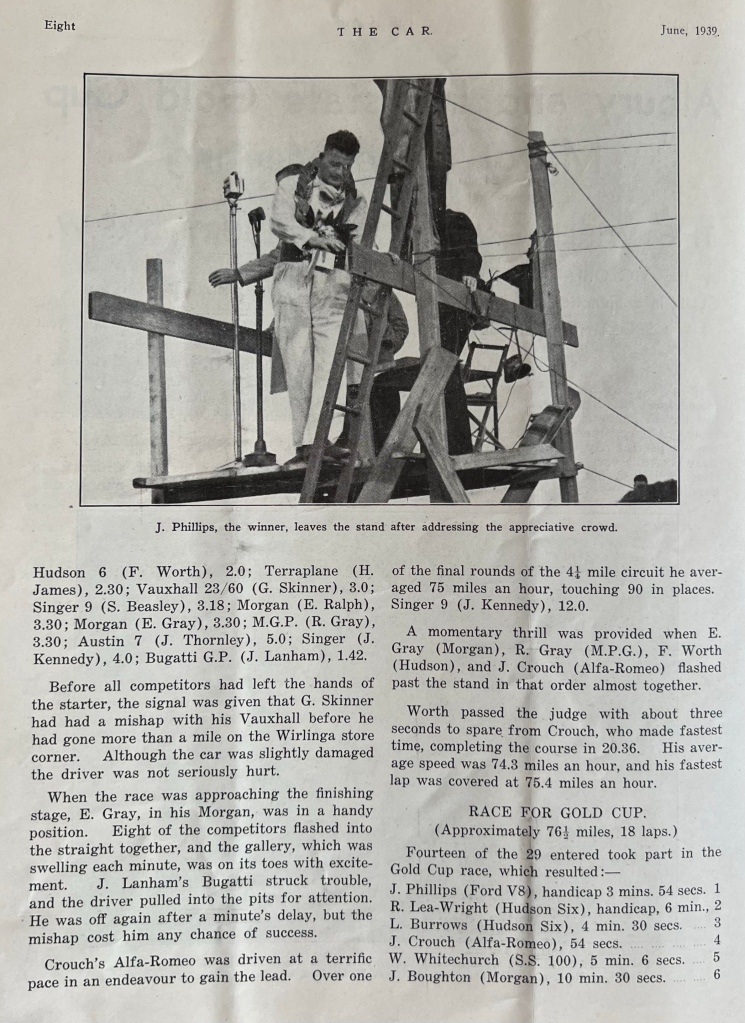
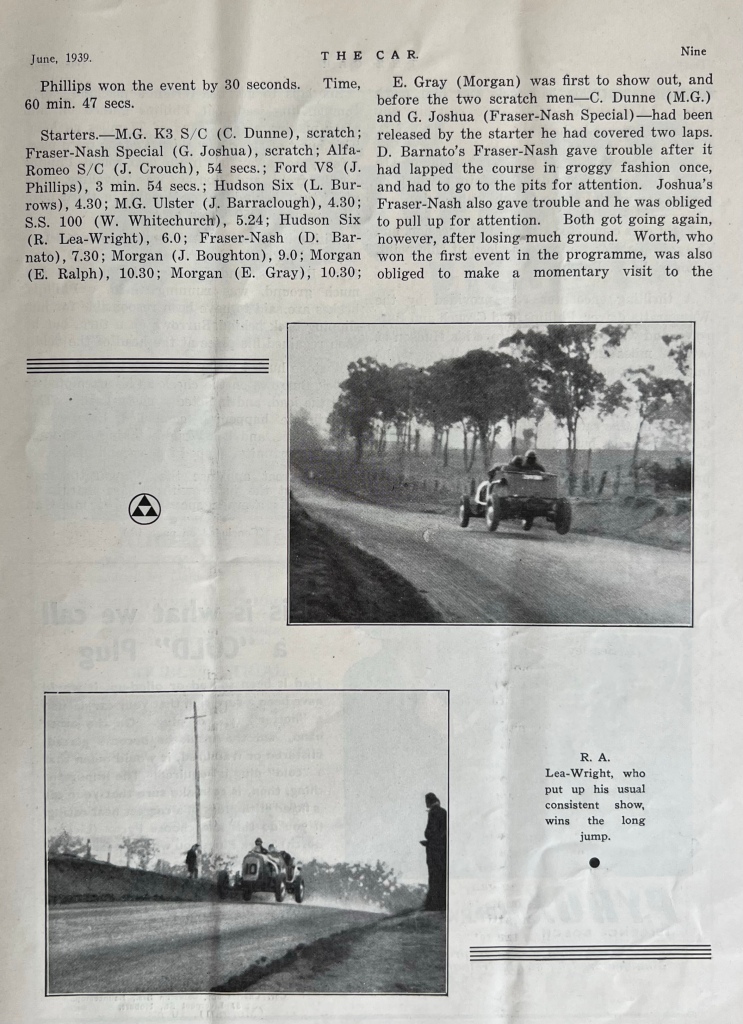
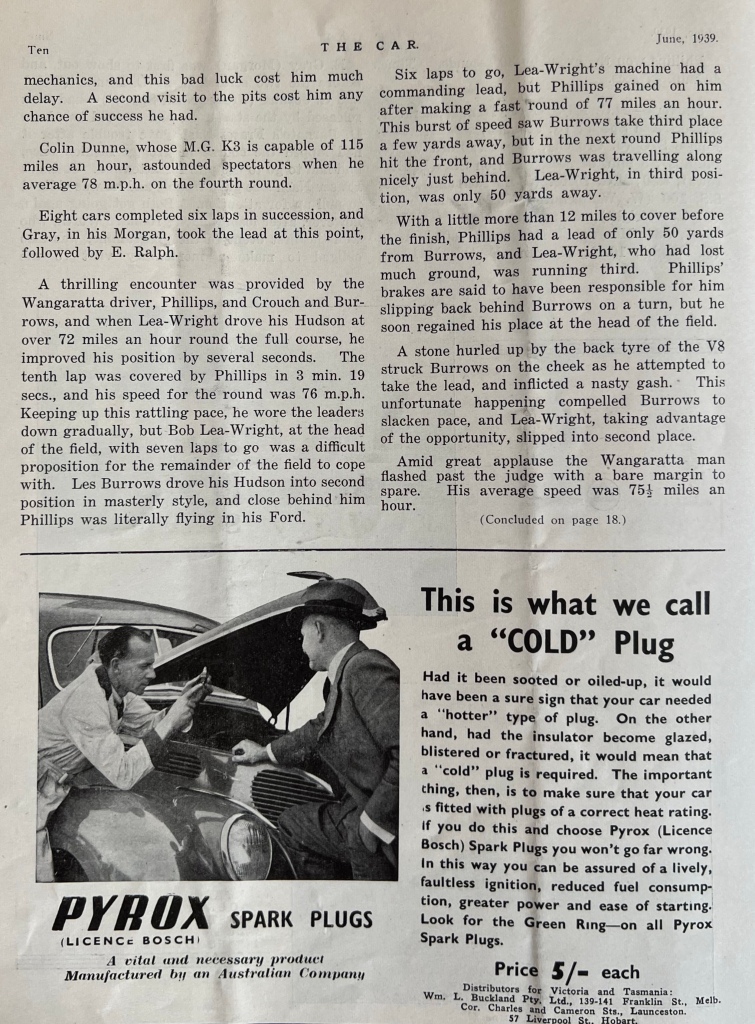
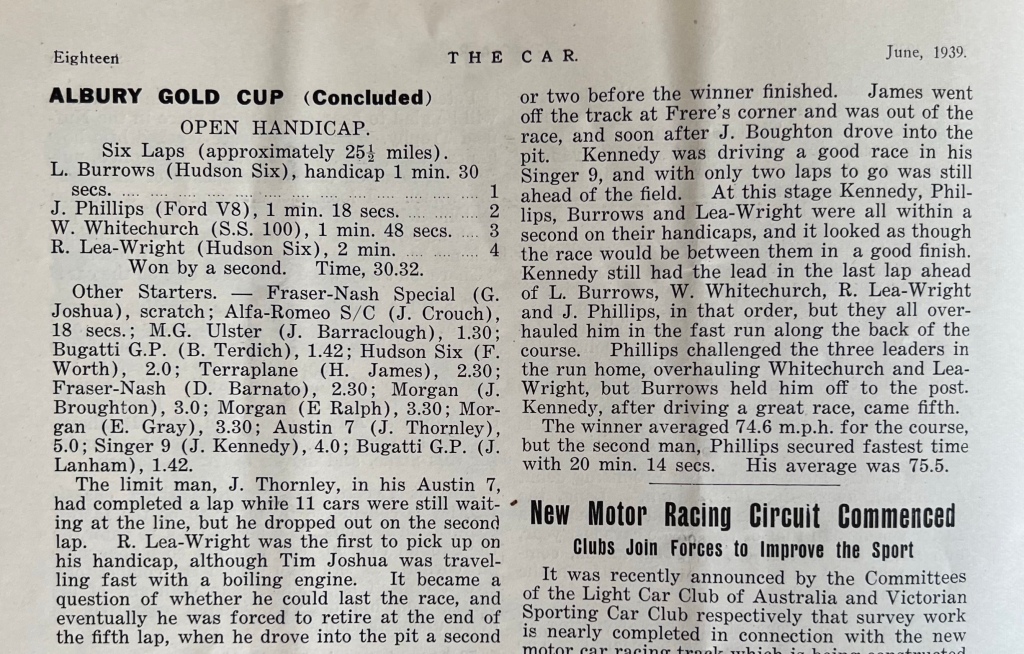

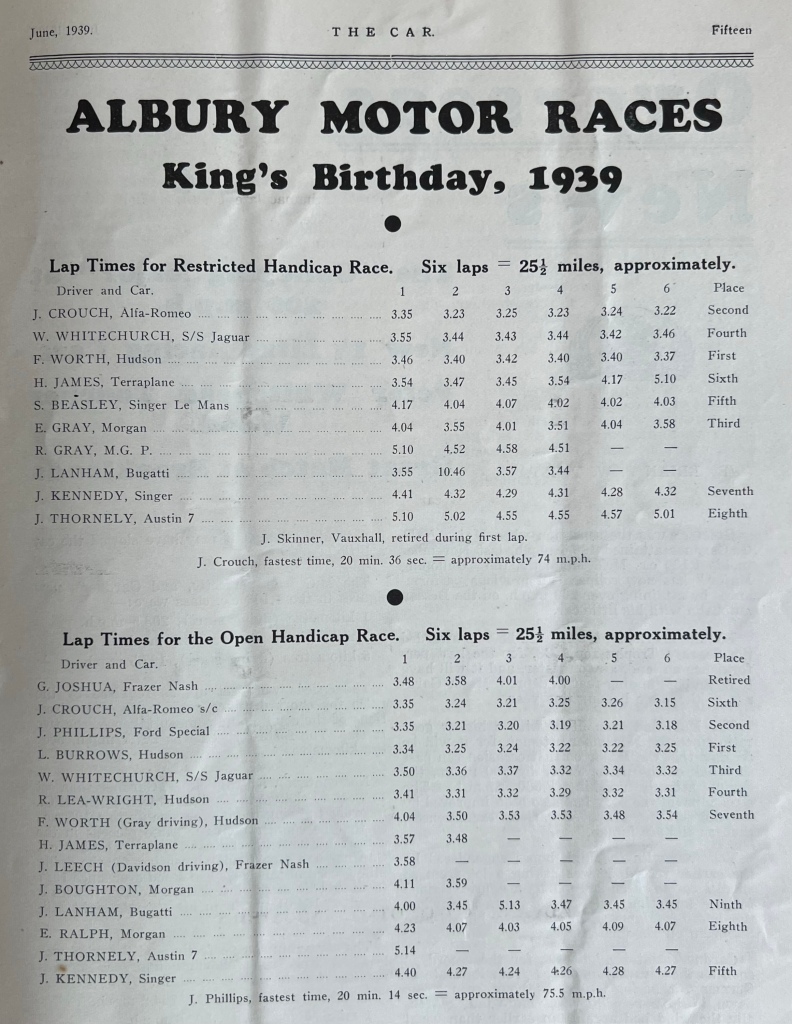
Credits..
The Car June 1939 via the Bob King Collection…
Finito…







Credits..
The Car June 1939 via the Bob King Collection…
Finito…

The Jack Phillips – Ted Parsons 1934 Ford V8 was Australia’s fastest of the breed pre-war. Here the machine is aviating on the Wirlinga road circuit – 10km northeast of Albury – on the Kings Birthday weekend in June 1940. The duo are on what was then called Orphanage Lane (now St Johns Road), the two crests which allowed the cars to take to the sky were near Corrys Road, Thurgoona, many thanks John Medley and Ray Bell.
The car was one of the most successful of all Australian racing cars in the immediate lead up to the conflict, placing sixth and third in the 1938 and 1939 Australian Grands Prix at Bathurst and Lobethal respectively. “In Victoria for the 1937-38 season, the Phillips Ford was awarded ‘The Car Trophy’ for the most successful competitor,” John Medley wrote.
The duo also won the Interstate Grand Prix/Albury and Interstate Cup on the Albury-Wirlinga road course in 1938-39 and the South Australian 100 at Lobethal in January 1940. On the same day the pair finished second to Les Burrows’ Hudson Terraplane Special in the Lobethal 50.

As the lights were progressively turned down throughout 1940, the Phillips/Parsons pair were ninth in the Easter Bathurst 150 mile race won by Alf Barrett’s Alfa Romeo Monza. The car’s final meeting before being put on display for much of the conflict in their Wangaratta Motors Ford dealership was the 75 mile Albury and Interstate Cup Race on June 17, 1940. It was the final meeting on this road course and Barrett set the all-time lap record at 2 minutes 52 seconds but broke an axle and retired from the race. Harry James’ Terraplane won in a steady performance from John Crouch’s Alfa Romeo 8C2300 Le Mans with Phillips/Parsons third.

Based on a fire-damaged ‘34 sedan with over 20,000 miles on the clock, the car was modified in the partner’s Wangaratta, Victoria Ford dealership by fitment of a special, swoopy, lighter body. Engine enhancements included twin Winfield carburettors, Scintilla magneto, modified heads and free-flowing exhausts.
Timed at 115mph in top gear, it did 80 in second – at a then heady 6000rpm – using the 3.5:1 rear axle ratio. It was a paragon of solid reliability too, not suffering the overheating afflictions of so many modified Ford flatties.

John Medley observed the car’s strengths, “The Phillips Ford simply soldiered on in prewar races on dirt and gravel roads, built tough to last to the finish. It continued to race postwar particularly in Victoria and South Australia where it was raced by South Australian Granton Harrison, by which time the newer breed of generally smaller and lighter V8 Specials could out-pace it.”
“Still it had been the mould in which the later V8s were shaped. In the postwar period, with T-Series MGs, Ford V8 specials were the backbone of Australian road racing.”
The Phillips/Parsons Ford was destroyed when it was crashed into a bridge, the remains were scrapped. Ted Parsons Jnr and his son Rob recreated the car between 2008-2014, the car took its bow at Winton in 2014.

Historian, Rob Bartholomaeus has worked out, by looking at his photographic archive, that a rebuild involving lightening and lowering the car and replacing the ’34 grille with a 1935 unit and a change in colour scheme from the one above, to the diagonal stripes shown in most of the other shots was made in late 1938 rather than 1937 as documented elsewhere. It seems the car started with underbody exhausts, then evolved to the side exhausts as above which were retained after the car was modified and repainted.
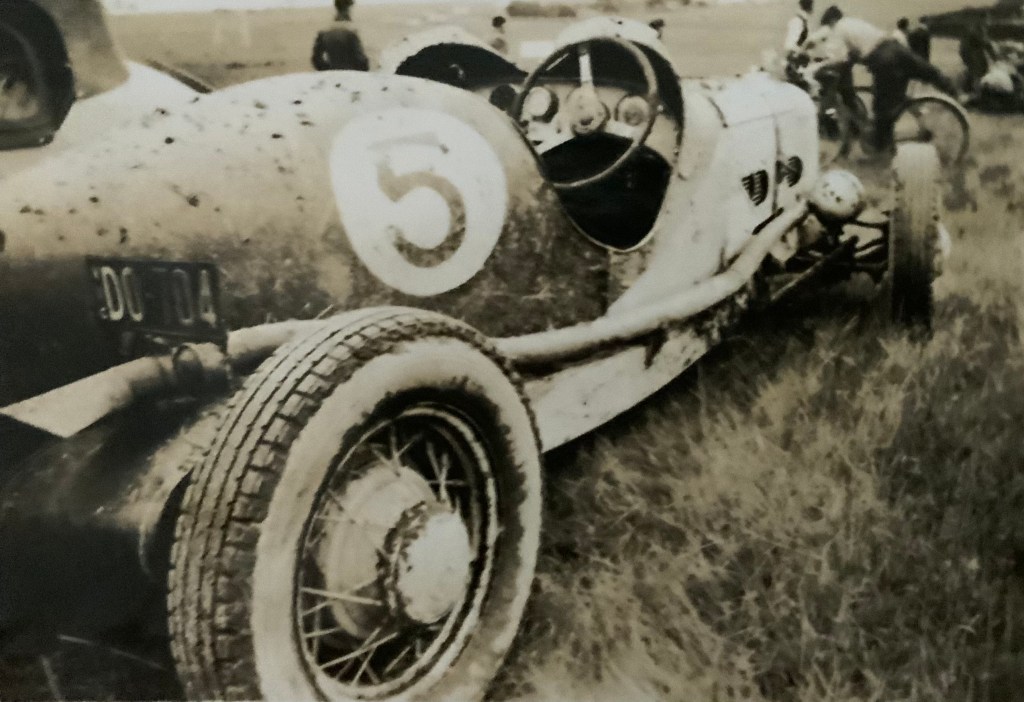
As noted above, the car’s last pre-war meeting was at Wirlinga in 1940. Bob King has this photograph in his collection, the caption on the back lists the racer as Bill Sinclair and the place, Oakleigh in 1942. I can find no Trove reference to this meeting at what is now a southern suburb of Melbourne. It appears as though the car is running the same number/roundel combination from Wirlinga, quite probably untouched. If anybody has information about the event do get in touch.

It’s not clear when Granton Harrison bought the machine but he added to its tally of Australian Grands Prix entries, racing it at Point Cook to Melbourne’s west in 1948, where he placed fourth, and in 1950 at Nuriootpa in South Australia’s Barossa Valley where he was 11th in the race won by Doug Whiteford’s Ford V8 Special ‘Black Bess’, Bess was inspired by the Ossie Cranston and Phillips/Parsons Ford V8s.
The shot above is of Granton contesting the South Australian 100 at Lobethal on New Years Day, 1948. A good day for him too, he was second behind Jim Gullan’s Ballot Oldsmobile Special – and did fastest race time in the handicap event – continuing this car’s reputation for competitive reliability.
Back to the sequence of owners. Stephen Dalton has Granton advertising the car for sale in the February 1948 issue of Australian Motor Sports, with Jack O’Dea running it at Rob Roy in January 1949, perhaps Jack ran it as a borrow/view to purchase. As we can see Granton raced on for a couple of years after that, if anyone can help with the ownership sequence, do get in touch.

Etcetera: The Warren Safety Aviation Helmet…
WT Warren invented the Warren Safety Helmet in 1912. The spring-equipped pilot safety helmet, made of leather and cork with vented ear collars was padded with horse hair and designed to minimise head injuries, the major cause of aero accident deaths at the time. The helmet was part of RAF listed kit issue from 1920-24.
Later models incorporated an ear audio piece and a breathing mask. By the time Phillips and Parsons used them they had been pensioned off by the RAF. Curtis and Taut & Co made the helmets under licence, the inscription in Parsons’ helmet, retained by the family, reads ‘No 2 Tuatz & Co Patent 17855 Aviators Safety Helmet. Maker Tautz & Co, Hunting Military and Multifit Tailors, 12 Grafton St, New Bond St, London.’

Rob Parsons explained further, “While the helmet was obsolete for aircraft, they were used by Phillips and Parsons from 1935-39. With a lack of sporting regulations, these cars lacked the safety features of safety belts which were not considered a benefit for car racing. Drivers had a steering wheel and the co-driver a grab handle to hold onto. It would be common in rollovers to duck-down and brace yourself, perhaps to be trapped or otherwise flung free of the car, all with grave consequences.”
“Ted Parsons first introduction to motor racing was at the Benalla Airstrip circuit, perhaps a likely place to find such a helmet. On the back page of his photo album, he list drivers who died racing during his involvement, a reminder of the sport’s dangers. He retired from racing after the war to pursue golf and film-making.”
“Jack and Ted wore leather face shields to protect themselves from their own flying stones and other track debris, an idea adapted from the oxygen flying mask. The leather was painted white to match the colour of the car, aviation goggles protected their eyes,” Parsons wrote.
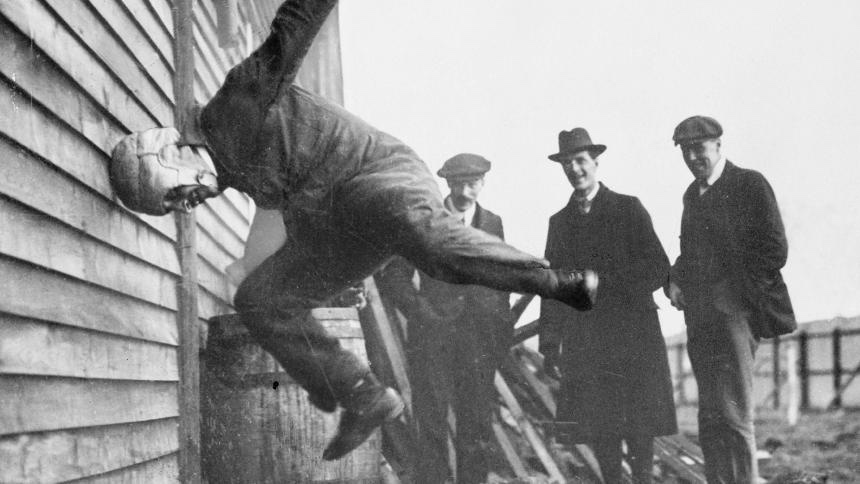
WT Warren tests his new helmet – as one does – by headbutting the wall of William Ewen’s Hendon flying school, where Warren was a trainee, in 1912.
What follows is the German-English translation from an article in Der Spiegel.
“In a 1912 issue of Flight magazine, British inventor WT Warren’s invention, a protective flight helmet is demonstrated. The image is often erroneously reported to be a football helmet.”
‘The wall against which the helmet carrier ran belongs to the flying school of William Hugh Ewen. The owner (middle) and and his chief pilot LWF Turner (left) are behind. The Lord in the foreground is his student Mr WT Warren. And, no, he has not failed the flight test and is just reacting to his anger.” Clearly the German hilarity is lost in translation.
“Dated 1912, Mr Warren is a tinkerer. He introduced his latest invention to experienced pilots: a protective helmet ‘that will attract considerable attention’, Flight magazine wrote. Warren’s leather cap was padded with horsehair: A system of steel springs should intercept any impact, thus reducing the risk of injury. Head injuries were the leading cause of death in flight accidents.”
Credits…
‘John Snow:Classic Motor Racer’ John Medley, State Library of Western Australia, cars4starters.com.au, Bob King Collection, ‘The Warren Safety Aviation Helmet’ by Rob Parsons in the July 2021 issue of ‘The Light Shaft’ – Austin 7 Club magazine, Parsons Family Collection via austin7club.org, John Dallinger, Der Spiegel
Tailpiece…
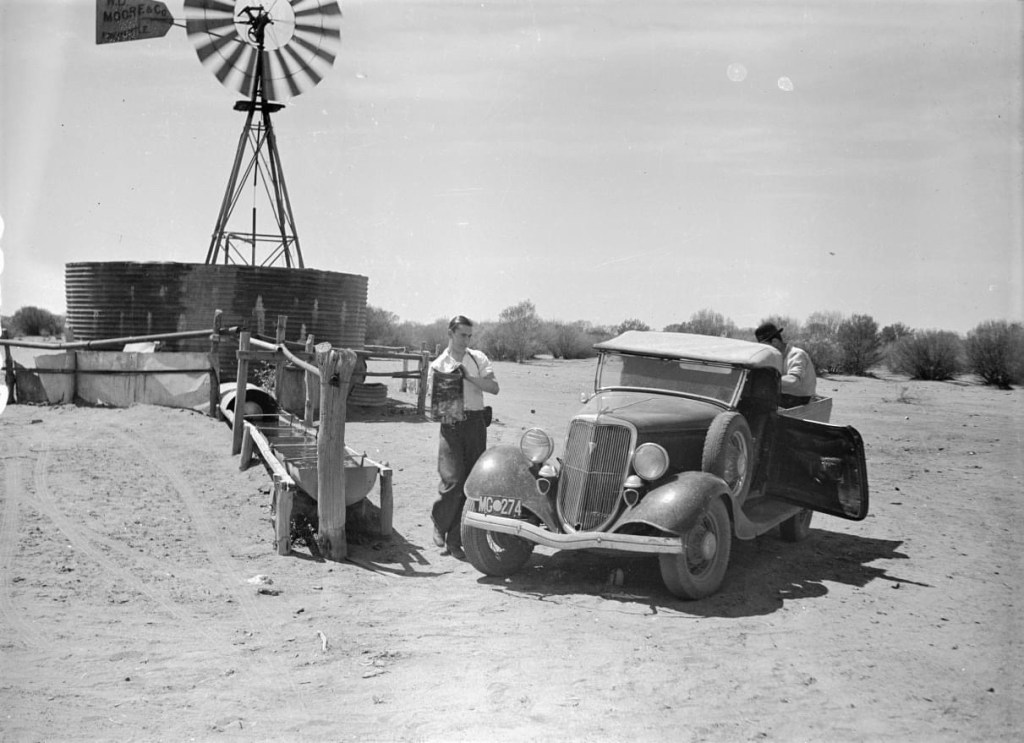
I’m cheating a bit, this 1934 Ford is a V8 ute rather than a sedan, but you get the jist of it.
The Phillips-Parsons racer was not too far removed from a roadie, rather than an out-and-out bespoke racer, reliant as it was on the standard chassis, axles wheel to wheel, differential and gearbox.
The ute is singing for its supper, doing a meat delivery in country Western Australia in 1937.
Finito…
Jack Phillips and Ted Parsons looking happy with themselves aboard their Ford V8 Special having won the Interstate Grand Prix at Wirlinga, Albury on 19 March 1938.
The Ford V8 found its way into all kinds of Australian specials both pre and post war, this was one of the most beautifully built and successful of them all. See here for a piece on this race; https://primotipo.com/2019/01/11/interstate-grand-prix-wirlinga-albury-1938/
These two mates were business partners in a motor dealership in Wangaratta which distributed Ford and other brands. I wonder if one of the admiring, capped kids is Jack’s son Ron Phillips who was a star in an Austin Healey 100S and Cooper T38 Jaguar in the mid-fifties to early sixties?
It’s pretty boring writing about familiar stuff, the journey of discovery is far more engaging. I think a lot about racing in the context of the times, how people lived, what they did with their leisure hours but it’s not necessarily easy to find the right photographs.
Not so this time, John J ‘Jack’ Dallinger ran a photography business, which still exists in Albury. Along the way, he and his staff recorded the daily lives of the citizens of the border city and surrounds, I’ve chosen some images of typical life justaposed with racing shots. All of the photographs were taken by Dallinger and his team in Albury in the thirties, unless attributed otherwise.

Locomotive’3623’ leaves Albury Station during the thirties. Obviously some sort of special occasion for the train to be decorated as it is

Albury Show wood-chopping competition, takes me back to watching the O’Toole brothers on Channel 7’s Sunday ‘World of Sport’ in the sixties
Motorcycle racing blazed the trail for cars in just about every sphere of competition in Australia, speedways included.
This is Aub Boyton aboard a Douglas, perhaps a 500cc DT5 or DT6- Douglas being one of the most popular and successful speedway bikes of the era.
Jim Boughton, Morgan at Wirlinga in 1938.
A year later this car had morphed into a single-seater in time for the Australian Grand Prix at Lobethal the following January, he failed to finish the race won by Allan Tomlinson’s MG TA Spl s/c. Better still, the Morgan remains extant.
Out and about in an Austin 7, this one is fitted with a James Flood built two seater sports body.
Of all steel and ash construction, the machine used a factory supplied radiator cowling forward of which was a fairing covering dummy dumb irons onto which was painted the registration number. The running gear comprised a production Austin chassis and mechanicals with a raked steering column.
Large flowing wings kept the elements from the occupants. ‘As was fashionable with many Australian models of this period, fixed split front windscreens were mounted on the scuttle with no provision of any weather protection’, many thanks to Tony Johns on this little Austin.
Keen spectators taking a look at competitors in the Wirlinga paddock prior to the 1938 Interstate Grand Prix.
Car #3 is Tim Joshua’s Frazer Nash, not too far from being restored, alongside is former Maroubra ace Hope Bartlett’s MG Q Type and then car #6, the winning Ford V8 Spl of Phillips/Parsons.
Billycart race in Pemberton Street, Albury 1940s.
Too much roll stiffness? is that right front taking some air. I wonder if either of these two young tyros progressed to motorised competition?
I’m sure one of you will be able to help with the Dodge Ute model year, 1930s, i’m also intrigued to know the address of Albury Motors Pty. Ltd.
The CA Williamson Chrysler ahead of G Winton, AC and L Evans Vauxhall, Wirlinga 1938.
Golden Arrow on display in Albury, a bit on the machine here; https://primotipo.com/2019/06/04/wot-the-bloody-ell-is-that/
Bill Boddy, in MotorSport, wrote that after an exhibition tour of Australia the car returned to England, that line is written in such a way which implies the car made the trip here after setting the Land Speed Record at Daytona at 231.446 mph on 13 March 1929. So, its later in 1929, the machine was owned by the Wakefield Company, clearly a lot of Castrol lubricants were sold here at the time.
Sir Henry Segrave was later killed aboard ‘Miss England II’ on 13 June 1930 after raising the Water Speed Record to 98.76 mph at Lake Windemere.
Tony John’s sent in a snippet from the April Fools Day edition of the 1931 ‘Bulletin’. “Drag” wrote ‘It is not often that one finds a car that has travelled 43,000 miles without an overhaul, and a racing car at that…the late Segrave’s Golden Arrow…left England on February 6 for the Buenos Aires exhibition after having made a tour of the Dominions. All its journeying has been done on board a ship, with the result that it has covered, by this means, over 1,000 times the distance it has done under its own power.’
Credits…
John J Dallinger, Tony Johns Collection, Terdich Collection-VSCC scanned by Graham Miller and shared by his son David via Tony Johns
Etcetera…
After upload our friend Tony Johns got in touch with these photos, ‘Having read your post i now understand the origin of these two photos in the Arthur Terdich Collection (winner of 1929 AGP @ Phillip Island). I was not aware the Golden Arrow ever came to Australia’ nor was I.
Some quick work on Trove reveals the car did a comprehensive tour of Australia in April-May 1930 taking in the west, and eastern seaboard, with over 70,000 people reported as seeing the car in Sydney’s showgrounds.
23.9 litre Napier Lion VIIA W-12 engine produced 930bhp @ 3,400rpm. Designed by John Samuel Irving and built at Kenelm Lee Guinness’ Robinhood Engineering Works Ltd, at Putney Vale, in 1928. First run in January 1929, LSR of 231.362mph at Daytona on March 11, 1929.
Terdich was a Melburnian so the above photograph was probably taken at the Royal Exhibition Buildings in the first week of May, ‘Motorclassica’ is held there these days, car shows continue at the marvellous old venue.
Checkout the rare, period cockpit shot of Bluebird below, it is not clear if Bluebird was touring at the same time as Golden Arrow.
‘Not sure that a current F1 driver would have time to read all the instruments’ Tony wryly observes. There are ten gauges to take in whilst travelling over 200mph- tach, petrol, blower (pressure or temps?) , one obscured, a clock!, then to the left are a car club and St Christopher badges?, then an adjustable knob on the chassis rail itself. On the right are axle temp, water, another temp gauge with another two at the bottom, plus Malcolm Campbell Ltd and Blue Bird brass plates.
Tailpiece: Albury Sports Ground 1930s…
Finito…
Bill Cuncliffe, 22 years of age guides his ex-Snow Sefton Strathpine Ford V8 Spl around the wide open spaces of Lowood in 1956…
Dick Willis shared these wonderful, evocative photographs of Cuncliffe at the ex-RAAF Airfield circuit in Queensland’s Somerset Region 70 Km west of Brisbane.
The mountains (you would call them hills in Europe or North America) are the Great Dividing Range which runs down the east coast of Australia from ‘top to bottom’.
The 4.2 litre Ford V8 powered device was quite a formidable machine for a young driver- Bill continued to race into the sixties, he finished eighth in the 1963 Bathurst 500 touring car classic aboard a Ford Cortina GT shared with fellow Queenslander Barry Broomhall.
Built by Snow Sefton at his Lawnton Motors garage in Gympie Road, Strathpine, the Ford V8 Spl contested both the 1949 Leyburn and 1954 Southport Australian Grands Prix.

Sefton on the Leyburn AGP grid 1949. From L>R- #22 George Pearse MG TB Spl, #18 Garry Coghlan MG TC Spl, #17 Dick Cobden MG TC Spl, #7 Alan Larsen Cadillac Spl V8 (Willis/Thallon)
At Leyburn Sefton raced this car, his more conventional ‘Strathpine Spl’ V8 racer ‘having competed elsewhere in Queensland with a Ford V8/Jeep hybrid which allowed a choice of either front drive or four- wheel drive’ Graham Howard wrote in ‘The History of The Australian Grand Prix’.
At Southport, Sefton raced ‘basically the same car he had run in the 1949 AGP at Leyburn’ retiring after completing 21 of the 27 lap scratch race won by Lex Davison’s HWM Jaguar.
Ray Bell reports that the special was fitted with a more powerful and reliable ohv Cadillac V8 by the end of the fifties.

Snow Sefton in the Strathpine Ford V8 Spl in Gympie Road Strathpine in the late 1940’s, out front of his garage perhaps. Awesome if somewhat noisy road car (B Pritchard)
Sefton was the proprietor of the Lawnton Motors for more than thirty years, he competed at all of the Queensland venues post-war. ‘Snow was always the crowd favourite at the Exhibition Speedway every Saturday night in Brisbane with his black and white 1936 Ford (the No 36). Snow’s sponsorship deal for the 1936 Ford is a classic story in itself and involved some of Brisbane’s biggest Holden Dealers! He was also famous for thrilling country crowds with his staunt driving at shows all over Queensland up until the early 1960’s’ said the CHACC.
Etcetera…
The photographs below are of Bill Cuncliffe during the 1957-1958 period.
Cuncliffe at the Samsonvale Hillclimb where he was second fastest time of the day. Samsonvale is 35 Km north of Brisbane. Looks like a wild place, the rugged special well suited to dirt surface.
Assistance with the owner/drivers lined up below welcome. Sid Sakzewski Porsche 356?
The photographs below are at the Strathpine Airfield circuit.
That location is 25 Km from Brisbane to the north and was a major Queensland motorsport venue from the end of the war until the opening of Lakeside in 1961.
Snow Sefton is credited as one of the driving forces in establishing Strathpine, he and fellow enthusiasts ‘borrowed the Pine Rivers Shire Council road making machinery’ to finish the track for the first meeting on 11 August 1946.
‘They worked like beavers all weekend, returned the equipment before dark on Sunday night, then wired the fence back up. (Most of the councillors were farmers who lived out of town and would not have heard the racket)’ the CHACC reported.
The color shots just ooze the atmosphere and vibe of the times, we are uncertain of the meeting dates- quite probably more than one meeting, note the missing radiator cowl in one image.
Cuncliffe getting some encouragement from his mates before the off by the look of it! Below the radiator cowl is missing- hors de combat or removed for additional cooling I wonder?
Photos above and below are taken on the same Strathpine day it seems, sans radiator cowling, Quentin Miles thinks his father Bill took the photo below in 1957.
It really is a most agreeable looking race venue isn’t it, got a real picnic hamper feel to it?
Credits…
Dick Willis Collection, Don Thallon Collection, Ray Bell, Bill Miles via Quentin Miles, ‘The History of The Australian Grand Prix’ Graham Howard and Others, ‘CHACC’- Classic and Historic Automobile Club of Caboolture magazine article in September 2005
Tailpiece: Cuncliffe, Lowood 1956…
Finito…